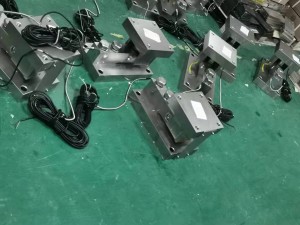Сёння мы раскажам, як вызначыць, ці нармальна працуе датчык.
Перш за ўсё, нам трэба ведаць, пры якіх абставінах нам трэба ацэньваць працудатчыкВось два пункты:
1. Вага, паказаная індыкатарам узважвання, не адпавядае рэальнай вазе, і ёсць вялікая розніца.
Калі мы выкарыстоўваем стандартныя вагі для праверкі дакладнасцімаштабКалі мы выявім, што вага, паказаная індыкатарам, значна адрозніваецца ад вагі тэставай гіры, і нулявая кропка і дыяпазон вагаў не могуць быць зменены каліброўкай, то трэба праверыць, ці не пашкоджаны датчык. У нашай рэальнай працы мы сутыкнуліся з такой сітуацыяй: вага ўпакоўкі корму на вагах складала 20 кг (вагу ўпакоўкі можна ўсталяваць па меры неабходнасці), але пры праверцы вагі ўпакоўкі электроннымі вагамі яна альбо большая, альбо меншая, што значна адрозніваецца ад мэтавага аб'ёму 20 кг.
2. На індыкатары з'яўляецца код сігналу трывогі "OL".
Гэты код азначае залішнюю вагу. Калі індыкатар часта паказвае гэты код, праверце, ці добра працуе датчык.
Як вызначыць, ці нармальна працуе датчык
Вымярэнне супраціву (індыкатар адключэння)
(1) Было б значна прасцей, калі б была інструкцыя да датчыка. Спачатку вымерайце ўваходнае і выхадное супраціўленне датчыка мультыметрам, а затым параўнайце яго з інструкцыяй. Калі розніца вялікая, значыць, ён пашкоджаны.
(2) Калі няма інструкцыі, вымерайце ўваходны супраціў, які ўяўляе сабой супраціўленне паміж EXC+ і EXC-; выходны супраціў, які ўяўляе сабой супраціўленне паміж SIG+ і SIG-; супраціўленне моста, якое складае EXC+ да SIG+, EXC+ да SIG-, супраціўленне паміж EXC- да SIG+, EXC- да SIG-. Уваходны супраціў, выходны супраціў і супраціўленне моста павінны адпавядаць наступнай суадносінам:
"1", уваходны супраціў>выхадны супраціў>супраціўленне моста
«2», супраціўленне моста роўнае або роўнае адзін аднаму.
Вымярэнне напружання (індыкатар уключаны)
Спачатку вымерайце мультыметрам напружанне паміж клемамі EXC+ і EXC- індыкатара. Гэта напружанне ўзбуджэння датчыка. Існуюць напружанні пастаяннага току 5 В і 10 В пастаяннага току. Тут у якасці прыкладу мы возьмем напружанне пастаяннага току 5 В.
Выхадная адчувальнасць датчыкаў, да якіх мы дакраналіся, звычайна складае 2 мВ/В, гэта значыць, выхадны сігнал датчыка адпавядае лінейнай залежнасці 2 мВ для кожнага напружання ўзбуджэння 1 В.
Калі няма нагрузкі, вымерайце мультыметрам значэнне mV паміж лініямі SIG+ і SIG-. Калі яно складае каля 1-2 mV, гэта азначае, што яно правільнае; калі значэнне mV асабліва вялікае, гэта азначае, што датчык пашкоджаны.
Пры нагрузцы выкарыстоўвайце файл мультыметра mv для вымярэння значэння mv паміж правадамі SIG+ і SIG-. Яно будзе павялічвацца прапарцыйна вазе нагрузкі, а максімальнае значэнне складае 5 В (напружанне ўзбуджэння) * 2 mv/V (адчувальнасць) = каля 10 mV. Калі не, гэта азначае, што датчык пашкоджаны.
1. Нельга перавышаць дыяпазон
Частае перавышэнне дыяпазону прывядзе да незваротнага пашкоджання эластычнага корпуса і тэнзаметра ўнутры датчыка.
2. Электразварка
(1) Адлучыце сігнальны кабель ад кантролера дысплея вагі;
(2) Зазямляльны провад для электрычнай зваркі павінен быць усталяваны побач з зваранай дэталлю, а датчык не павінен быць часткай электрычнага зварачнага ланцуга.
3. Ізаляцыя кабеля датчыка
Ізаляцыя кабеля датчыка вымяраецца супраціўленнем паміж EXC+, EXC-, SEN+, SEN-, SIG+, SIG- і зазямляльным провадам экранавання SHIELD. Пры вымярэнні выкарыстоўвайце мультыметр. Перадача павінна быць усталявана на 20M, а вымеранае значэнне павінна быць бясконцым. Калі гэта не так, датчык пашкоджаны.
Час публікацыі: 27 снежня 2021 г.






